A Manually Pressurized Chain Oiler
The Cobrra Nemo2 chain oiling system is about as simple as it gets.
It has a reservoir, feed tube, drip orientation component and the oil of your choice.
Simplicity vs. complexity; it really is “back to basics” regarding the Nemo 2.
And that goes also for an installation on the electronics-laden, high-stepping BMW S1000XR (review).
But neither has complained so far and the Nemo 2 system looks and works just fine on the XR.
A true manual system, the Nemo 2 doesn’t require the rider to lubricate the chain by hand.
But the hands are involved in filling, priming and initiating drip or lubrication sessions on a periodic basis.
The process isn’t quite as “set and forget” as other automatic (electronic) chain lube systems, but once you become used to the routine, it’s easy.
Chain lubrication is initiated while riding with simple 90- or 180-degree turn of the bezel on top of the Nemo 2 reservoir; the reservoir mounts on the handlebar.
The Nemo 2 is very versatile.
It can use almost any weight or type of oil — often a good thing depending on weather and riding environment factors. I’ve been using the Scottoiler “Blue” warm-weather oil and so far, so good.
Cobrra claims a reservoir range of up to 5000 km (3,100 miles), although that is likely only with fairly light use.
But nevertheless, if even close, it is still a sign of a very efficient feed system.
At just over 700 km (434 miles) of use with the Nemo 2, the reservoir level is still just fine, as I expected.
As an unabashed geek of all things high-tech, especially motorcycle related, the very basic but modern engineered Nemo 2 sits very well with me.
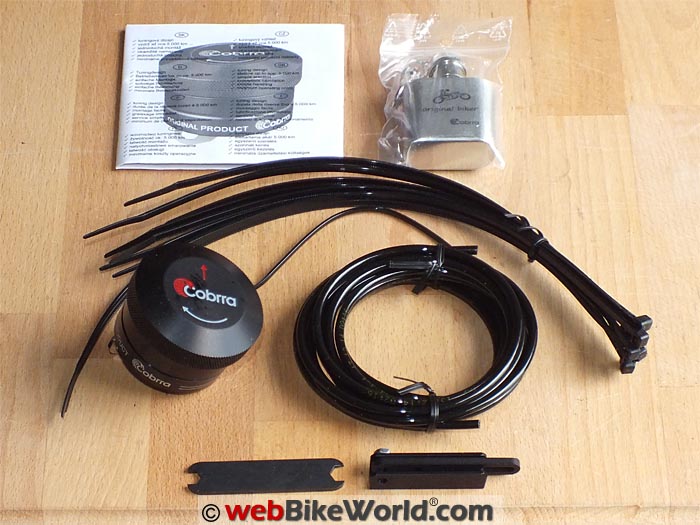
Where to Buy Cobrra Nemo 2 Chain Oiler
Check Reviews & Prices on Amazon Check Reviews & Prices On RevZillaSee More: Motorcycle Chain Lube, Motorcycle Accessories, Motorcycle Lubricants
Introduction
Recently relegated to “second newest” status by my spouse’s 2015 BMW R 1200 GSW, the 2016 BMW S1000XR is getting lots of use and after a planned trip end-September, I will add an update to the BMW S1000XR First Impressions report.
The accessorizing or farkling has been going full tilt since the XR passed its first service check with flying colours, although accessorizing does cut into the riding time, something that will be very precious in a few months…
So while there are lots of things on the list to be installed and reviewed for this continuing wBW series.
Once the radiator guard, oil cooler guard and the BMW engine guards were installed (reviews coming soon), a chain oiler was next.
By chance, the Editor had sent me the new Cobrra Nemo 2 Chain Oiling System earlier in the summer and while originally thinking it would go on to the F 800 GS Adventure — already adorned with a vacuum-based Scottoiler chain oiler (review) — the new XR was sans an oiler.
This is known as an opportunity!
Nemo 2 Kit Components
The small box containing the Nemo 2 is well packed with the essentials needed, along with a couple of marketing “bling” items.
It includes the Nemo 2 reservoir (a multi-chamber counter-rotating reservoir), a thin black plastic feed hose that is 286 cm (112 inches) in length and the reservoir housing, made from a light aluminum alloy.
An adjustable guide arm for the drip tube is included, which helps locate the exact position for the tip of the drip tube, just over the chain.
Cobrra also includes an aluminum wrench for service and for adjusting the drip tube guide arm. Several zip ties and two small adhesive cushion pads, along with a basic multi-language diagram-based instruction set (.pdf) is also included.
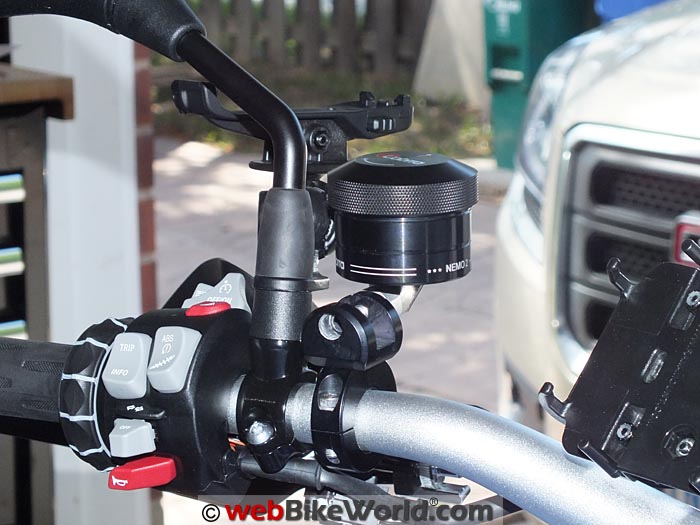
The Cobrra Nemo 2 Chain Oiler System
Of course, proper lubrication (and cleaning) optimizes chain efficiency, while extending the life cycle of the chain and related components; never a bad thing.
There is much to be said for a gravity-fed or a pressure- or vacuum-based motorcycle chain oiling system. There are a few of each that have been around for a long time and have their fans.
Over the years, webBikeWorld has reviewed many chain lubes and chain oiling systems and personally I have used a great many of them on and off road over the long haul.
All have been without failure, less a cranky electronics module that was quickly replaced by Scottoiler on one of the first Scottoiler E-systems (review) we reviewed.
Developed by Cobrra in Slovakia, the Nemo 2 consists of a light aluminum alloy reservoir that mounts on the handlebar.
The reservoir consists of three interconnected chambers that are filled with chain lube oil and which then control the system, which is manually pressurized by the rider by turning the top bezel on the Nemo 2 housing.
The pressure provides uniform lubrication while it also self-lubricates the internal Nemo 2 parts.
As noted on the Cobrra website, the Nemo 2 works on the principle of compression, where the oil is displaced under pressure. It is not a gravity-fed system.
Cobrra says that because the system is pressurized, you don’t have to change oil viscosity in different riding temperatures. The pressurization keeps the oil flowing whether it’s cold or hot.
There are no electronic or electrical components in the Nemo 2. The only requirement is mounting the reservoir in an easy-to-reach location and, of course, mounting the oil tubing and the drip tube correctly.
The feed hose and adjustable guide for the drip tube are mounted so the hose tip is positioned above the chain, just in front of the sprocket.
This drip tube positioning is just like any other automated chain oiler system, such as the Editor’sCameleon chain oiler (review) currently mounted on the Suzuki V-Strom 1000 ABS (Blog).
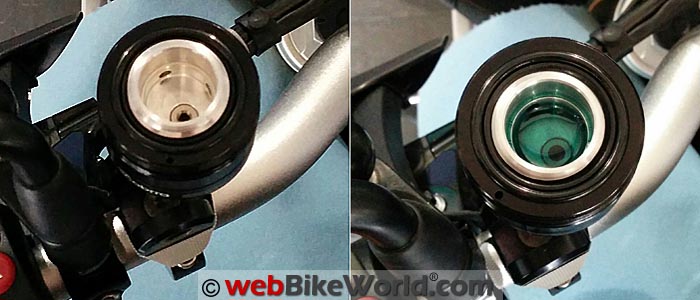
Where to Buy Cobrra Nemo 2 Chain Oiler
Check Reviews & Prices on Amazon Check Reviews & Prices On RevZillaSee More: Motorcycle Chain Lube, Motorcycle Accessories, Motorcycle Lubricants
Oil for the Nemo 2
The Nemo 2 works in rainy conditions, dusty environments and on long trips. The lubrication is maintained by internal pressure in the system, which is created by the rider with regular 90-degree turns of the control ring or bezel located on the top of the Nemo 2 reservoir.
Lubrication can be increased or decreased depending on riding conditions.
To increase the oil flow to the chain and to prolong the drip, a 180-degree turn is used, and where less oil flow or a complete stoppage is desired, a 45-degree anti-clockwise turn serves to depressurize the system, reducing oil flow.
There is a printed arrow on the top of the cap, which indicates how far the bezel has been turned.
Just about any oil can be used: 80W-90 transmission oil; “tacky” oil for high speed riding; “Bio” oil for off-road use or other suitable chain lube oil. Cobrra says that some savings can be made because you don’t have to use the sometimes costly specifically designed motorcycle chain lube oil.
Reservoir Fill Intervals
A single fill of the Nemo 2 reservoir can provide chain lubrication for up to ~5,000 km (3,100 miles), according to Cobrra. This depends, of course, on the oil type/weight used and the riding conditions.
An oil level alert is visible when there is about 500 km remaining, by observing the bottom of the reservoir (more on this later).
The Nemo 2 reservoir is filled directly from a container by removing the cap and adding oil in stages via the small inner chamber.
Cobrra claims that the Nemo 2 does not dispense oil if the motorcycle is stopped and the system is depressurized. Although the Nemo 2 has not been in service on the S1000XR for very long, the claim is pretty much spot on (pun intended).
Initial filling, priming and subsequent top-up steps for lubricating the chain and de-pressurizing action to stop or minimize dripping when the motorcycle is stopped are all described in the Function and Performance section below.
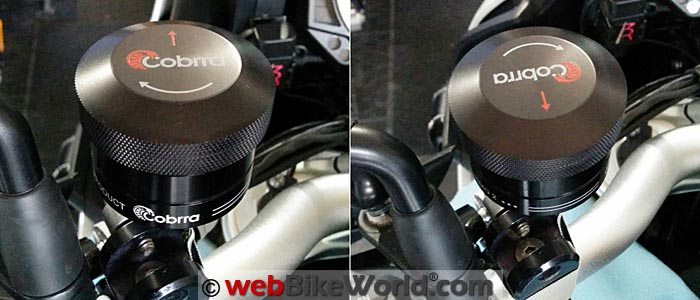
Installing the Nemo 2
There is no disputing that the Nemo 2 is one of the simplest chain oilers around and that fact carries over to installation as well; this will be a viable solution for many (many) chain-driven motorcycles.
Unfortunately, I did not have one of the nifty Cobrra Nemo 2 Universal Holder brackets ($35.00 option) that would have worked great for mounting the Nemo 2 reservoir on the handlebar.
Instead, I found a spare TechMount bracket and put it into service. This small clam-shell or clamp mount component fits perfectly, located 15 mm to the right of the left mirror mounting bracket on the S1000XR.
The pivoting U-bracket from the TechMount kit screws into the top of the clamp mount and a spare 10 mm spacer was added to push the Nemo 2 reservoir forward a bit, providing more clearance for a SHAD SB23 tank bag when the forks are turned full left lock.
Mounting the Nemo 2 reservoir so that it is level when the handlebars are in the straight-ahead position is a requirement for optimum performance.
With everything just finger tight, I used a short bubble level to provide guidance in getting vertical and horizontal positioning set.
From this point, the securing button-head screws were fully tightened, while keeping an eye on the level.
One end of the thin black plastic feed tube was then inserted directly up into the plastic pressure fit valve on the bottom of the Nemo 2 reservoir.
It doesn’t take much force; stop when resistance is felt — it will be seated.
I located the tube to run down to the left side back to the steering head and along the left side of the frame sharing the generous space between the aluminum frame and one of the electronic components with some other accessory harnesses.
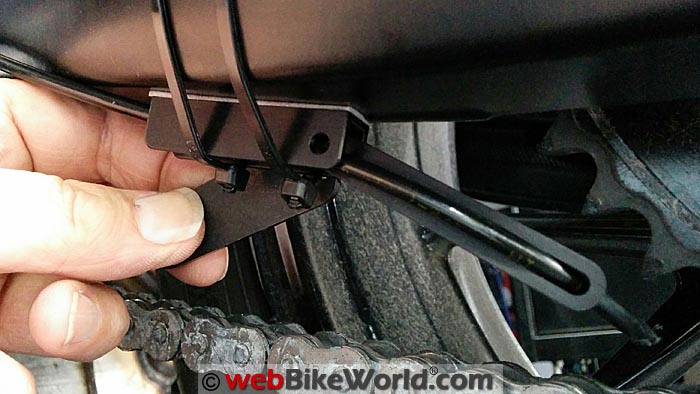
Locating and Mounting the Oil Feed Tube
Where the main beam of the aluminum frame on the S1000XR turns downwards, the Nemo 2 oil feed tube parts company with the other harnesses that continue back to the under seat area.
The oil feed tube for the Nemo 2 sits in some adhesive cable clips, which act as guides for the tubing while letting it flex somewhat on its path down to the swing arm.
Just above the swing arm pivot point, the tubing angles over the top of the Pro Shift Assembly and then to the lower side of the swing arm. Two more adhesive clips keep the tubing guided as it runs back to a point in front of and above the rear sprocket.
There is lots of tubing here, so after making sure I had at least 3 cm of slack or so in the run from the reservoir down and another 10 cm or so of excess at the drip end, I used a wire cutter to cut the excess off.
This also made working with the somewhat stiff tubing easier also.
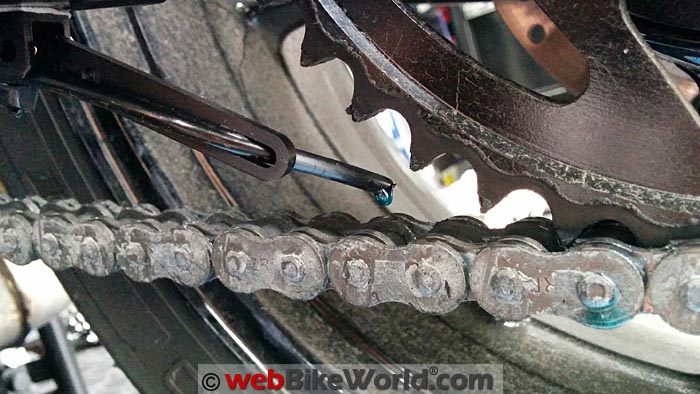
Where to Buy Cobrra Nemo 2 Chain Oiler
Check Reviews & Prices on Amazon Check Reviews & Prices On RevZillaSee More: Motorcycle Chain Lube, Motorcycle Accessories, Motorcycle Lubricants
Mounting the Drip Tube
The drip tube end of the Nemo 2 has an adjustable guide arm that serves to locate the tip of the drip tube end above the chain. It is a small aluminum U-channel piece with its extension or orientation arm joined with a small hex-head screw to form a strong mounting point.
The top of the tube guide has a thin adhesive strip on it for adhering the piece to the underside of the swing arm.
However, I had (uncharacteristically) cleaned the swing arm with Goo Gone, then soap and water and a cold water rinse to get things nice and clean for the work and more importantly provide a clean mounting surface for the adhesive.
After some placement tests with the tube now fed through the tube guide and the extension arm that serves to angle the tube at about 45 degrees left for positioning over the rear sprocket, I found a good mounting position over the chain.
The instructions show the optimal position for the drip tube end as a location that will drip the oil 1 mm in from the inner edge of the chain plate that faces the outside. In other words, just inside the outer chain plate.
I peeled off the adhesive cover strip from the guide and stuck in place, but it didn’t stick at all and immediately fell off. So, Plan B it is…
After cleaning the thin weak adhesive strip with Goo Gone and drying the surface, I cut a strip of my favourite 3M VHB (Very High Bond) double-sided tape.
I then adhered it to the guide and allowed it to cure for an hour (even though it doesn’t typically need much initial curing).
Plan B did the trick!
Once positioned and pressed in place for a minute, the fix was in; the tube guide and extension arm weren’t going anywhere.
Although the extension arm is tight against the guide, taking a firm push to move it, if needed the joining hex-head screw can be loosened off and retightened using the thin stamped wrench supplied with the kit.
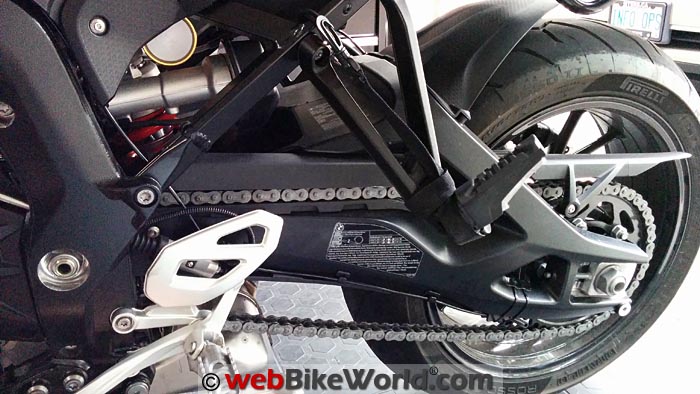
Function and Performance
The Nemo 2 really is very simple to use, although the procedure used to fill, pressurize and thus lubricate the chain is a bit complicated and the rider must develop some different habits. See the video above for a quick instruction.
Holding the Nemo 2 reservoir housing and removing the lid in anti-clockwise fashion reveals a small inner chamber of aluminum.
This chamber is filled first with oil, then the reservoir housing is turned anti-clockwise, which then disperses the oil into the other two chambers.
It takes three of these small fillings to bring the housing to its anti-clockwise stopper point, whereupon one more top-up of the middle chamber serves to complete the filling process.
Now the lid with the bezel and its arrow indicator can go back on.
With the lid in place, a 90-degree clockwise turn of the housing initiates the pressurization and after waiting one minute, the housing is given a 180 degree clockwise turn as the initial priming or filling action.
This is followed by a three minute wait to see if this initial action has been successful.
To my surprise, it had.
A few drops had already come off the delivery end of the tubing onto the clean dry shop cloth laid down in the drip pan to visually capture the event.
Two more 180-degree filling actions provided verification that all was good. A few seconds after each, the drip starts for about ten seconds and then tapers off to a drop every ten seconds or so.
On the Road With the Nemo 2
In general use, a 90-degree turn serves to activate the lubrication drips (known as a “drip session”) from the Nemo 2 system.
This is something that the rider needs to do about every 150 to 350 km or so or more frequently, depending on riding conditions.
Longer-lasting drip sessions can be initiated by a 180-degree turn; particularly good in wet or muddy conditions so to maintain optimal lubrication.
Cobrra claims that the reservoir can provide enough oiling for up to 5000 km (3,100 miles), based on standard use as described above.
Determining reservoir oil status can be done two ways:
By removing the lid and checking the status of oil in the chambers (e.g. seeing how much can be added) or somewhat quicker by checking the bottom of the housing itself (the need to keep this part clean must be emphasized).
In viewing the bottom of the housing, a light colouration is an indicator that oil level is low; a dark colouration indicates that the oil level is still good.
Refilling the reservoir is done as per the initial filling actions described earlier.
To interrupt the flow after a riding session is complete, a 45-degree anti-clockwise turn serves to depressurize the system slightly.
And for all intents this does interrupt any further flow, although depending one or two drips might still come off the drip end.
I keep a small rectangular drip tray in place under the chain when the bike is parked in the driveway or in the garage, although overall dripping has been very minimal.
Conclusion
In remembering that the Cobrra Nemo 2 is truly a manual chain oiling system (no vacuum or electronics-based output control), it is a very effective and very efficient product.
Just remember to do the 90- or 180-degree pressurization feed sessions as identified or needed and the chain will receive its lubricating and life extending oil.
I have just two observations: First, the stiff feed tube might become even less pliable with the coming colder temperatures, which may or may not become an issue depending on the rating for the tube.
And second, I’ve been wondering whether the reservoir could be moved back to the rear frame of the bike, shortening the feed run while still providing easy access when stopped.
However, this might eliminate the ability to lube on-the-go.
There is no shortage of chain oiling systems on the market today, ranging from absolute simplicity, like the Nemo 2, to some very sophisticated and extremely reliable devices.
And while not everyone buys into the argument that these systems are better than chain lube sprays, something like the Nemo 2 can making the oiling process far more efficient and thus effective.
Where to Buy Cobrra Nemo 2 Chain Oiler
Check Reviews & Prices on Amazon Check Reviews & Prices On RevZillaSee More: Motorcycle Chain Lube, Motorcycle Accessories, Motorcycle Lubricants
Owner Comments and Feedback
See details on submitting comments.
From “H.S.” (September 2016): “I read your article on the COBRRA Nemo2 chin oiler.
First, it actually looks like something a person would like to have mounted as an accessory, and not an eyesore. Seems simple enough.
However, I question just how well the inner (or opposite side) O-rings really manage to be lubricated, with the oil dispensed on only one side.
Seems like 80-90% of the lubrication would be remaining on the one side, to be flung off as the excess builds up, while the other side would barely receive enough to lube the O-rings and help keep the road grit off.
Overall, I really like the system design and feel it would accent the look of my ZX-14R SE nicely — but I would probably mount it somewhere down on the frame, and not on the handlebars.
With the exception of only the single delivery tube, it might be about perfect. All these other space-age units that require wiring and use GPS, etc., are making installation far more complex than it should be for such a simple task.
Thanks for your testing and info!”
Editor’s Reply: The single tube delivery is commonly used even on powered chain lube systems. The manufacturers usually claim that the lube or oil will travel to the rest of the chain by capillary action.
So even the Cameleon oiler I use on a couple of bikes has a single drip tube and it seems to work just fine at lubing the entire chain.
You don’t need much at all — much less than most people think. If the chain looks oily or if there’s any fling-off at all, then it’s too much.
Also, the chain lube should not/won’t be enough to remove grit from the chain, you still have to keep it clean, by the way.
From “D.D.” (September 2015): “Well written review. As many of us like to add farkels for no reason other than we can, this one seems to be worthy of consideration — expensive, useful, and oh so simple!”
From “J.W.” (September 2015): “Just read the review and unless I’m missing something it appears that only the outside chain plates get lubed. What about the inside plates?”
Rick’s Reply: Actually, that’s pretty much the case with any automatic oiler. It depends on how the drip tube is located. Also, some oilers have dual tips. But the idea is that once the oil drips on the chain, it flows out and around to all parts of the chain, and that’s been my experience.
The only issue is the outside of the plates, they still need an occasional brushing and spray to keep off the rust. And the chain needs to be cleaned every once and a while.”
From “F.M.” (September 2015): “Can’t someone just make a simple little lever or rubber button (like the old-style starting bulbs on lawn equipment) that mounts on the handlebars that delivers a little squirt of oil to the chain?
I don’t need adjustable flow rates, a pressurized system, an electric pump, engine vacuum sensing, accelerometers, or LCD displays. Just give me a lever to tug or a button to push and I’m sure that I’d remember to operate it often enough to keep the chain happy.
Since it would be finger-operated, it could be called “digitally controlled” by the Marketing department if that would make them feel better.”
Editor’s Reply: Yes, there are a few like that. But there are a few problems — first, you don’t know how much oil to drip, it only takes very little oil at intervals to do it correctly.
Also, most people wouldn’t have the timing correct for how and when to do it, so it’s easier to simply let an automated system do the oiling.
While the Nemo 2 is sort of a hybrid manual/auto system, it’s actually very easy to install and simple to operate.
From “C.H.” (September 2015): “Is there something I’m missing with these chain oilers? I squirt chain wax on my chain every time I get gas and at the end of the day on long trips. It takes maybe a minute and my chains last in excess of 20,000 miles.
It seems between the cost of purchasing the oiler system, the frustration of mounting, and topping off the reservoir one isn’t really coming out ahead versus just lubing the chain the old way.”
Rick’s Reply: I used to feel the same way, but to be honest, I never had the discipline to lube the chain as much as it probably needed it and I think very few people will take the time to do it after or before every ride.
There are a few reasons why a chain oiler is a good solution:
- It’s not as messy as spraying chain lube.
- Some people don’t have a center stand or paddock stand, which makes the job more difficult.
- Some bikes have an exhaust or side bags that make it difficult to reach the chain, making a manual lube difficult.
- The cost of cans of good chain lube can add up to more than the cost of an automatic oiler over time.
- An automatic oiler works continuously, rain or shine, every time you ride.
I use a Cameleon oiler on the V-Strom and once it’s installed, it’s maintenance and worry free.
It’s not really a big deal to install one but that is the most difficult part. But once it’s in, it’s pretty much set it and forget it. I have to remind myself once and a while to check the oil level but the oil lasts several thousand miles.
Again, I never thought much of automatic oilers in the past but once I installed one, I realized I’ll probably never go back to manual sprays again.
From “T.B.” (September 2015): “I’m sorry, but I have to agree with S.D. My Tutoro automatic version is fuss free. I did have some initial adjustment to get the dual feeder to stay oriented on my sprocket, but it definitely was not what I would call hard or difficult.
I’m getting about 2,000mi out of a reservoir fill on the Tutoro and that might even be set too high. Also, please note that Tutoro states in the instruction manual that alternate oils can be successfully used and gives examples of those oils.
As a disclaimer, this is my first oiler and I do respect wBW’s breadth of knowledge.”
From “S.D.” (September 2015): “Well simple didn’t translate to cheap! At $149 I think I will stick with hands-off Tutoro. Plus you don’t have to look at it all the time.”
Editor’s Note: The Tutoro is much harder to locate and mount on the bike and the Tuturo manual system needs adjusting also. The Nemo 2 is super easy to install can use any kind of oil in any temperatures since it’s pressurized, which is a big advantage and saves more money in the long run.
Other WebBikeWorld Chain Lube Posts

